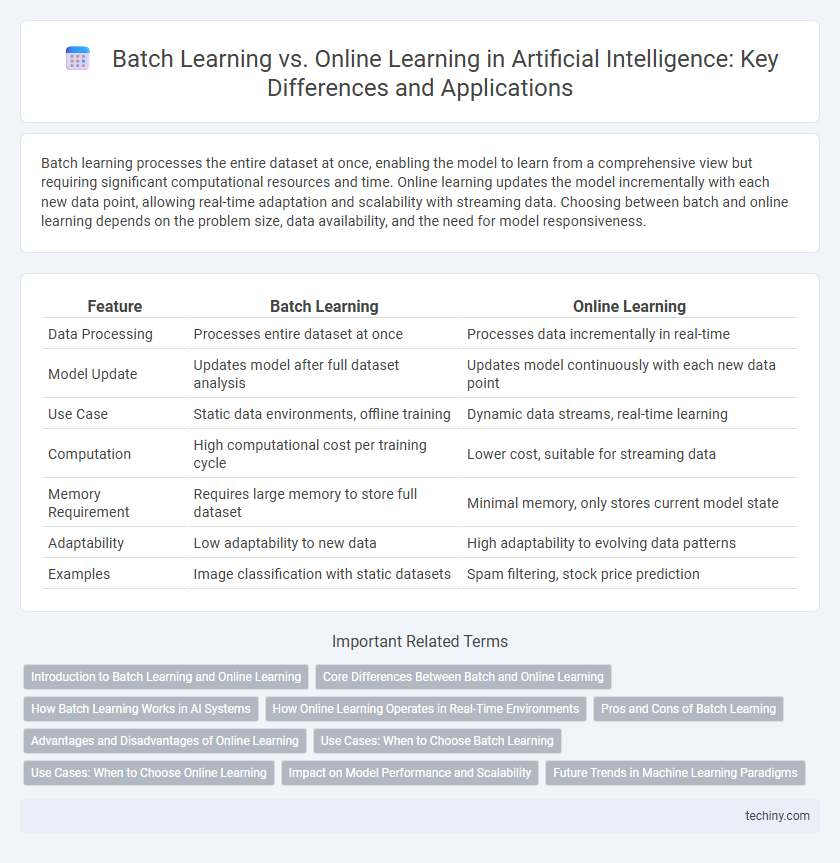Batch learning processes the entire dataset at once, enabling the model to learn from a comprehensive view but requiring significant computational resources and time. Online learning updates the model incrementally with each new data point, allowing real-time adaptation and scalability with streaming data. Choosing between batch and online learning depends on the problem size, data availability, and the need for model responsiveness.
Table of Comparison
| Feature | Batch Learning | Online Learning |
|---|---|---|
| Data Processing | Processes entire dataset at once | Processes data incrementally in real-time |
| Model Update | Updates model after full dataset analysis | Updates model continuously with each new data point |
| Use Case | Static data environments, offline training | Dynamic data streams, real-time learning |
| Computation | High computational cost per training cycle | Lower cost, suitable for streaming data |
| Memory Requirement | Requires large memory to store full dataset | Minimal memory, only stores current model state |
| Adaptability | Low adaptability to new data | High adaptability to evolving data patterns |
| Examples | Image classification with static datasets | Spam filtering, stock price prediction |
Introduction to Batch Learning and Online Learning
Batch learning processes large datasets in fixed-size groups, enabling models to train on complete data before updating. Online learning continuously ingests individual data points or small batches, allowing real-time model updates and adaptability to new information. Batch learning suits static environments with comprehensive datasets, while online learning excels in dynamic settings requiring immediate learning from streaming data.
Core Differences Between Batch and Online Learning
Batch learning processes the entire dataset simultaneously, enabling comprehensive model training but requiring significant memory and computational resources. Online learning updates the model incrementally with each new data point, allowing adaptation to evolving data patterns and real-time decision-making. Key differences include resource efficiency, adaptability to data streams, and suitability for static versus dynamic environments.
How Batch Learning Works in AI Systems
Batch learning in AI systems processes large datasets at once by training models on a fixed, pre-collected dataset. This method optimizes computational resources by iterating over the entire batch to minimize global error before model deployment. Batch learning is effective for applications requiring stable models and structured data without the need for real-time updates.
How Online Learning Operates in Real-Time Environments
Online learning operates by continuously updating its model parameters as new data arrives, enabling real-time adaptation without retraining from scratch. It processes data instances sequentially, allowing immediate response to changing patterns and environments. This method is crucial for applications like autonomous vehicles and stock market analysis, where instantaneous decision-making is essential.
Pros and Cons of Batch Learning
Batch Learning processes large datasets at once, enabling comprehensive model training with high accuracy and stability due to extensive exposure to data patterns. It demands significant computational resources and time, often causing delays in model updates and limiting adaptability to new information. While ideal for static environments, its fixed nature can reduce responsiveness in dynamic real-time applications.
Advantages and Disadvantages of Online Learning
Online learning in artificial intelligence enables real-time model updates, enhancing adaptability to dynamic data streams and reducing memory requirements compared to batch learning. It is highly efficient for environments with continuous data influx, allowing immediate incorporation of new information without retraining from scratch. However, online learning may suffer from catastrophic forgetting, where previously learned information is overwritten, and it often requires careful tuning to maintain stability and performance over time.
Use Cases: When to Choose Batch Learning
Batch learning is ideal for scenarios where large, static datasets are readily available, such as image recognition in medical diagnostics or fraud detection in financial services. It excels in environments requiring high accuracy and extensive model training offline before deployment, minimizing the need for real-time data updates. Batch learning also suits applications with predictable data patterns and infrequent model retraining, ensuring stability and robustness.
Use Cases: When to Choose Online Learning
Online learning is ideal for applications requiring real-time data processing and continuous model updates, such as fraud detection, dynamic recommendation systems, and adaptive user interfaces. It excels in environments with non-stationary data streams where batch learning's periodic retraining would be inefficient or impractical. This approach enables immediate adaptation to evolving patterns, enhancing responsiveness and accuracy in time-sensitive AI deployments.
Impact on Model Performance and Scalability
Batch learning processes fixed datasets, enabling models to achieve high accuracy through comprehensive training but often lacks adaptability to new data, limiting real-time responsiveness. Online learning continuously updates models with incoming data, enhancing scalability and real-time performance while potentially sacrificing accuracy due to incremental, noisy updates. Scalability in online learning supports dynamic environments and large-scale applications, whereas batch learning excels in stable contexts with abundant computing resources.
Future Trends in Machine Learning Paradigms
Future trends in machine learning paradigms indicate a growing shift towards hybrid models that combine batch learning's stability with online learning's adaptability to real-time data streams. Advances in edge computing and IoT integration will drive the adoption of continuous online learning to enable instant decision-making in dynamic environments. Enhanced algorithms will focus on achieving scalable, incremental learning while maintaining computational efficiency and robustness in evolving datasets.
Batch Learning vs Online Learning Infographic

 techiny.com
techiny.com